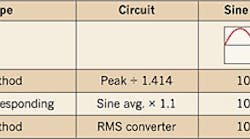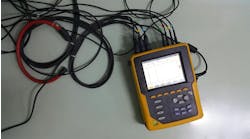The variety of test and measurement products available today can boggle the mind. From the mundane to the exotic, these instruments can practically lead you by the hand. However, if you don't have a full understanding of the measurements you're getting, you can become confused and possibly mislead others.
Let's take a brief walk through this potential minefield and discuss some important instrument measurement and performance characteristics.
Methods of meter calculations. All digital multimeters (DMMs) are calibrated to give rms indication. However, depending on the voltage or current signal you're measuring, the different methods used in instruments to calculate rms value may yield vastly different measurements.
Let's look at the most popular types to see how they arrive at rms values.
- Peak method
Meters using this method read the peak of the measured signal and divide the result by 1.414 to obtain rms value of that signal. So, if the signal waveform is undistorted, this method gives relatively accurate measurements.
- Averaging method
With this method, a meter determines the average value of a rectified signal. For a clean sinusoidal signal, it relates to the rms value by the constant “k” (1.1). As with the peak method, it gives accurate measurements if there's no waveform distortion.
- True rms-sensing method
This method uses an rms converter that does a digital calculation of rms value. It squares the signal on a sample-by-sample basis, averages the result, and takes the square root of the result. It gives accurate measurements, regardless of waveform distortion.
Let's take a look at the accuracy of each method's calculation, based on the signal being measured. Tables 1 and 2, on page C16, and Table 3 show sine, square, and switch-mode power supply current waveforms with an rms value of 1.0 per unit (p.u.), along with the corresponding measured value for each type of meter, “per unitized” to the 1.0 p.u. value. (See “The Basics of AC Current,” on page C22.)
Crest factor. The crest factor (C) of a waveform is equal to its peak amplitude divided by its rms value, or C = XPEAK ÷ XRMS. As you can see, crest factor is a dimensionless quantity. The IEEE dictionary has a somewhat different definition — one that is attributable to average reading or rms voltmeters: “The ratio of the peak voltage value that an average reading or root-mean-square voltmeter will accept without overloading to the full scale value of the range being used for measurement.”
DC voltages have a crest factor of 1, since the rms and peak amplitudes are equal, and it is the same for a square wave (50% duty cycle). For an undistorted sine wave, the crest factor is 1.414. For a triangle wave, it's 1.73. Crest factors for other waveforms are shown in Table 4 (click here to see Table 4).
Crest factor is an important parameter to understand when trying to take accurate measurements of low-frequency signals. For example, given a certain digital multimeter with an AC accuracy of 0.03% (always specified for sine waves) with an additional error of 0.2% for crest factors between 1.414 and 5.0, the total error for measuring a triangular wave (crest factor = 1.73) would be 0.03% + 0.2% = 0.23%.
A “true-rms” measuring instrument typically has a crest factor performance specification, which relates to the amount of peaking this instrument can measure without error. The higher the performance number, the better the performance of the device. You'll find these specification numbers in the range of 2.0 to 7.0. A typical DMM will have a crest factor number of 3.0, which is adequate for most distribution measurements.
Total harmonic distortion. The presence of harmonic currents will distort sinusoidal waveforms. In fact, the main culprit of power distribution harmonic problems is voltage distortion. As harmonic currents pass through a power distribution system's total impedance, they create voltage distortion. This is a simple application of Ohm's Law (VH = IH × ZH), where VH is the voltage at harmonic H, IH is the current at harmonic H, and ZH is the system impedance at harmonic H. The cumulative effect of these drops at each harmonic frequency produces voltage distortion.
Total harmonic distortion (THD) indicates the amount of waveform distortion. Voltage THD (VTHD) is the root mean square of all harmonic voltage drops. Current THD (ITHD) is the root mean square of all the harmonic currents. Percent harmonic distortion is the ratio of the square root of the sums of the squares of all rms harmonic voltages and currents to the fundamental.
You can characterize harmonic distortion at any point by the frequency spectrums of the voltages and currents present. However, you should take measurements over time to determine the statistical characteristics of the harmonic components. This is where spectrum and harmonic analyzers come into play. IEEE Std. 519, IEEE Recommended Practices and Requirements for Harmonic Control in Electric Power Systems, lists current distortion limits for general distribution systems.
Meter symbology. You'll find numerous electrical symbols on your DMM or oscilloscope, many of which are internationally accepted. Table 5 lists the symbols most commonly found on DMMs, along with an explanation of each. Table 6 on page C20 does the same for oscilloscopes. Make sure you're thoroughly knowledgeable of these symbols and functions before you set out to analyze a system or pinpoint that trouble spot.
To help you better use your diagnostic test instrument, we've included the following list of commonly used (and misunderstood) terms and definitions:
-
AC coupling: A mode of signal transmission that passes the dynamic AC signal component to both inputs of a scope but blocks the DC component. This is useful when you want to view an AC signal that's normally riding on a DC signal.
-
Attenuation: The decrease in amplitude of a signal.
-
Bandwidth: The range of frequencies a test tool can display accurately with no more than a manufacturer-specified amount of attenuation of the original signal.
-
Average: A technique to obtain the average value of a repetitive signal.
-
BNC: A coaxial-type connector used for the inputs of your test tool.
-
DC coupling: A mode of signal transmission that passes both AC and DC signal components to both inputs of a test tool.
-
Digital storage capability: Because of the design of digital oscilloscopes, these test tools do not display signals at the moment they're acquired. Instead, digital oscilloscopes store these signals in memory and then send them to the display.
-
Dual trace: A feature that allows a test tool to display two separate live waveforms at the same time.
-
Duty cycle: The ratio of a waveform with respect to the total waveform period, usually measured in percent.
-
Frequency: The number of times a waveform repeats in 1 second, measured in Hertz (Hz), where 1 Hz is one cycle per second.
-
Maximum peak: The highest voltage value of a waveform.
-
Minimum peak: The lowest voltage value of a waveform.
-
Percentage of pulse width: The ratio of signal on-time to its total cycle time, as measured in percent.
-
Root mean square (rms): The conversion of AC voltages to the effective DC value.
-
Sampling rate: The number of samples taken from a signal every second.
-
Time base: The time defined per horizontal division on a test tool display, expressed in seconds per division.
-
Trace: The displayed waveform showing the voltage variations of the input signal as a function of time.
-
Trigger level: The voltage level that a waveform must reach before a test tool will read it.
Grounding terminology and measurement devices. You may have seen the terms “isolated” and “grounded” on some test and measurement devices. Perhaps you've wondered, “What's the difference?” All manufacturers use the term “isolated” (and sometimes “electrically floating”) to denote a measurement where you do not connect your test tool's common (COM) to earth ground but instead to a voltage different from earth ground.
The term “grounded” is used to denote a measurement where you do connect the COM to an earth ground potential. Knowing this difference is important for your safety and the life of your test instrument.
Do not use an isolated test connection, as shown in Fig. 1, while taking measurements on an AC or DC circuit of several hundred volts to ground. Instead, use the differential 3-lead connection system, as shown in Fig. 2, for dual input measurements.
On almost all handheld scopes, you should connect the A-channel to the higher voltage (in relation to ground) and the B-channel to the other. If both test points are equal in voltage to ground, it makes no difference. Regardless, you should connect the A-channel to the signal (voltage) designated as the phase or zero-crossing reference (such as for the trigger sweep). Then, set both of your test tool's channels to the same input attenuation, AC or DC setting, and V/cm levels.
Safety and test equipment. Every manufacturer includes specific cautions and warnings to encourage safe use of its test instrument. Usually, a caution points out a condition and/or action that may damage your test tool. A warning, on the other hand, actually calls out a condition and/or action that may pose a hazard to you. Cautions and warnings are found throughout a user manual. Where absolutely necessary, you'll find them marked on the specific test tool.
Other helpful safety tips include a couple more rules of thumb. Don't exceed the working voltage of the input channel probes to ground. Check your instrument manual to find this value. Also, use available accessories to safely make differential measurements if your instrument doesn't have differential input capability or sufficient voltage rating.
Sidebar: The Basics of AC Current
The Figure shows a replication of the current waveform, which starts at zero, reaches a peak on the positive side of the zero axis, returns to zero, continues onto another peak on the negative side of this axis, and then returns to zero again. One combination positive-and-negative loop represents one cycle. In the United States, 60-Hz current goes through 60 complete sets of this loop in 1 second.
Thus, the question is, “If current reverses itself 60 times in 1 second, how can it be measured? After all, equal positive and negative values will cancel each other. The net result, then, should be zero.” The answer here is obvious. You're not measuring the actual current of the sine wave. Instead, you're measuring its heating effect.
Let's expand on the concept of heating effect. When a direct current is passed through a given resistance, this current produces heat. A car cigarette lighter is a good example of this phenomenon. Now, if you pass an alternating current through this same resistance, it will also produce heat. For both direct and alternating currents, their respective heating effects are proportional to I2R. In other words, the heating effects of both types of current vary as the square of their respective currents for the specific resistance. The larger the current, the more heat will be produced in the given circuit.
As mentioned above, don't base the value of alternating current on its average; instead, base it on its heating effect. In fact, the definition of an alternating current ampere is “that current which, when flowing through a given ohmic resistance, will produce heat at the same rate as a direct current ampere.”
For example, suppose you have 1A of direct current and 1A rms of alternating current. Because the magnitude of rms alternating current equals the magnitude of direct current, the former is equal in heating to the latter. If we square the alternating current by squaring each of its instantaneous values for both its positive and negative loops, we generate an I2R waveform. Because negative quantities squared are positive, the I2R wave for the negative loop of alternating current appears above the zero axis. Therefore, the average value of the I2R wave is 1A.
As previously discussed, heating varies as the square of the current (I2R). The square root of 1 is 1, so the 1A rms of effective current is equal to the square of 1A of direct current.



